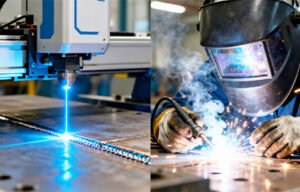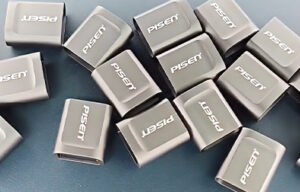The Secret Weapon to Boost Metal Processing Efficiency: Laser Welding Machines
1. Introduction
In today’s fast-paced manufacturing world, the demand for faster, more precise, and cost-effective metal processing solutions is higher than ever.
Whether you’re in automotive, electronics, kitchenware, advertising, or medical industries, increasing efficiency without compromising quality is essential for staying competitive.
Laser welding machines are a powerful technology that meets these demands.
2. Challenges of Traditional Metal Processing
Traditional welding methods like TIG, MIG, and resistance welding are widely used but face limitations in speed, precision, and automation compatibility.
Manual welding often results in inconsistencies, low efficiency, and rising labor costs.
3. What is Laser Welding?
Laser welding is a process that uses high-intensity laser beams to join metal components.
It supports deep penetration, high-speed processing, and precision control.
Fiber laser welding, in particular, is energy-efficient and highly compatible with automation.
4. Key Features of Laser Welders
High welding speed
Small heat-affected zone
Non-contact processing
Suitable for micro-welding
Low thermal distortion
Integrates with automation or CNC systems
5. How Laser Welders Improve Efficiency
Laser welding machines dramatically improve efficiency in five main ways:
Faster Welding Speed – Up to 2–10 times faster than traditional methods, ideal for continuous production.
Higher Welding Precision – Narrower welds with better control reduce rework and material waste.
Minimal Post-processing – Smooth welds and low heat impact reduce grinding and shaping.
Superior Automation Compatibility – Easily integrates with CNC or robotic arms for unmanned operation.
Lower Overall Energy Consumption – Focused energy use reduces power costs and enhances efficiency.
6. Industry Applications of Laser Welding Machines
Due to their high speed, precision, and minimal heat-affected zone, laser welding machines are widely used across many industries, including but not limited to:
Automotive: Battery modules, frames, exhaust pipes
Electronics: Connectors, electromagnetic shielding housings, precision electronic components
Kitchenware: Stainless steel sinks, cookware, oven parts
Medical Devices: Surgical tools, implant components
Jewelry: Precision welding of gold and silver items
Mold Repair: Restoration of injection molds, die-casting molds, and other metal tooling
New Energy Batteries: Lithium battery cases, tabs, electrodes
Small Appliances: Electric kettles, food processors, coffee machines, and other metal parts
Hardware Tools: Wrenches, cutters, fasteners, and structural welding
Furniture Manufacturing: Metal chair legs, structural frames
Advertising Production: Lightboxes, stainless steel letters, decorative components
7. Case Studies
Case 1: Automotive Battery Modules
A leading EV manufacturer reduced welding time by 50% and scrap rate by 30% after adopting fiber laser welding.
Highlight: Four-axis laser head with automatic path detection for consistent results.
Case 2: Kitchenware Manufacturing
A stainless-steel sink manufacturer doubled production capacity and halved polishing time by switching to handheld laser welding.
Highlight: Equipped with wobble welding system for complex weld geometries.
8. How to Choose the Right Laser Welder
Consider the following:
Type of materials
Material thickness range
Required welding speed
Automation needs
Budget and ROI expectations
Recommended models:
Handheld fiber laser welding machines
Desktop precision laser welders
CNC-integrated automated welding systems
For complex structures or variable welds, choose a welder with wobble function for better adaptability.
9. FAQs
Q: Can laser welding replace traditional welding?
A: Not completely, but in high-precision and high-efficiency fields, it significantly reduces dependence on traditional methods.
Q: Can beginners operate laser welders?
A: Yes, especially handheld types, which are user-friendly and easy to operate.
Q: What materials can be welded?
A: Stainless steel, carbon steel, aluminum, copper, brass, gold, titanium alloys, and more..
Q: What are the drawbacks?
A: Higher upfront cost and sensitivity to working environment and material surface cleanliness.
Q: Is shielding gas needed?
A: Yes. Common gases like nitrogen and argon help prevent oxidation and improve weld quality.
10. Conclusion
Laser welding machines have revolutionized efficiency in metal processing.
With faster speeds, minimal heat distortion, and excellent automation compatibility, they are a cornerstone of modern manufacturing.
For companies aiming to increase capacity, cut costs, and maintain a competitive edge, investing in laser welding is a smart move.
Contact our technical consultants for tailored solutions and expert advice.
111-1024x458.png)


